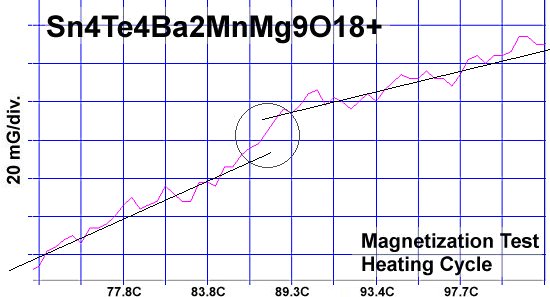
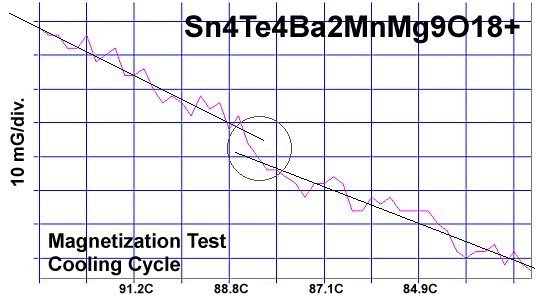




Through trial and error, Superconductors.ORG reports finding the most synergist combination of elements that can produce room-temperature superconductivity. The compound Sn4Te4Ba2MnMg9O18+ has been found to exceed the Tc-v-PWR curve of all previous discoveries. It has an exceptionally high aggregate dielectric constant (K), producing a critical transition temperature (Tc) around 87-88 Celsius (188-190F) with a planar weight ratio (PWR) of just 7.5:1. The Kappa of SnTe is 1770. And MnO2 has a colossal K of 10,000. This is the 44th room-temperature superconductor discovered to date.
To improve the commercial appeal of any room-temperature superconductor, its structure must be simple, producing maximum Tc with elements of low toxicity and sufficient hardness. The F212 target structure of this material is shown below left. Substituting magnesium into the copper atomic sites helps improve hardness while providing a small Tc boost.
The plots at page top show both heating and cooling magnetization tests, focusing on the Meissner transition of the stoichiometric phase. This mix is multi-phasic and has a low volume fraction (VF), as have all previous RTS discoveries. Straight lines have been drawn through the noise to emphasize the level-shift at Tc.
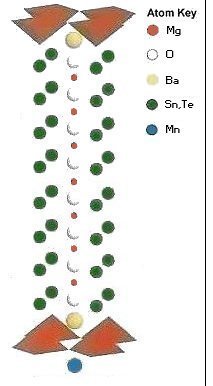
|
The below curves show transition temperatures plotted against planar weight ratios along the C1 axis for dozens of superconductors. A material is deemed most synergistic if its Tc point lies above all the legacy curves. Sn4Te4Ba2MnMg9O18+ is above the record 187C curve by about 3-4 degrees Celsius (see arrow pointing toward dashed line). This suggests the elemental combination Sn-Te-Ba-Mn-Mg-O could produce a Tc above 190C with a (Z+4)212 structure. This curve outperforms the thallium-cuprates by more than 80 degrees, highlighting the extraordinary ability of high-kappa compounds to promote Tc. 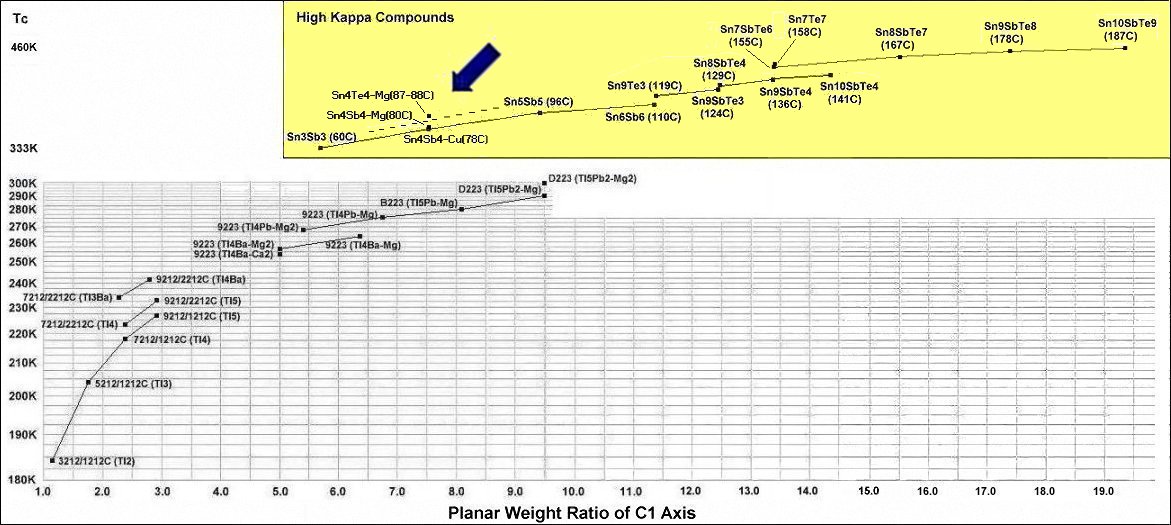
|
In order to maximize formation of the F212 structure, this compound was synthesized using the layer cake method, as shown below. The pellet had approximately 100 interference layers. And, even using this layering technique, the volume fraction is low, requiring very sensitive test equipment.
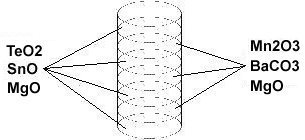
Stoichiometric ratios of the below chemicals were used for the ODD layers:
TeO2 99.99% (Alfa Aesar) 7.44 grains...and the below ratios for the EVEN layers.
Mn2O3 98% (Alfa Aesar) 0.92 grainThe chemical precursors were pelletized at 60,000 PSI and pre-sintered for 12 hours at 715C, then sintered at 880C for 12 more hours. Lastly the pellet was annealed for 10+ hours at 500C in flowing O2. Temperature was determined using an Omega type "T" thermocouple and precision OP77 DC amplifier. The magnetometer employed twin Honeywell SS94A1F Hall-effect sensors with a tandem sensitivity of 50 mv/Gauss.
RESEARCH NOTE: These materials can be strongly hygroscopic. All tests should be performed immediately after annealing.
RE-PUBLICATION NOTICE: Elsevier Publishing, dba Elsevier Science, as well as Morris Communications, both print and broadcast divisions, are specifically prohibited from re-publishing any part of this news story.
E. Joe Eck
© 2016 Superconductors.ORG
All rights reserved.
 BACK to "News" page at Superconductors.ORG
BACK to "News" page at Superconductors.ORG